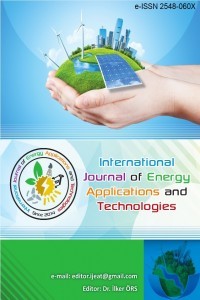Determination of optimum insulation thicknesses, energy savings and environmental impacts with respect to heating and cooling degree-days for different climate regions of Turkey
Determination of optimum insulation thicknesses, energy savings and environmental impacts with respect to heating and cooling degree-days for different climate regions of Turkey
Energy saving, optimum insulation thickness, payback period, environmental impact climate region,
___
- [1] A. Aytac& U.T. Aksoy, Enerji Tasarrufu iç ve Dış Duvarlarda Optimum Yalıtım Kalınlığı ve Isıtma Maliyeti ilişkisi, J. Gazi Univ. Fac. Eng. Archit., vol. 21, pp. 753–758, 2006.
- [2] T. Keskin, "Enerji Verimliliği Kanunu ve Uygulama Süreci", Mühendis ve Makina vol. 569, pp. 106-112, 2007.
- [3] N. Evcil, "Isı İzolasyonu ve Dış Duvarların Enerji Etkin Yenilenmesi", Yüksek Lisans Tezi, İstanbul Teknik Üniversitesi Fen Bilimleri Enstitüsü, İstanbul, 2000.
- [4] A.Ulaş, "Binalarda TS 825 Hesap Yöntemine Göre Isı Kaybı, Yakıt Tüketimi, Karbondioksit Emisyonu Hesabı ve Maliyet Analizi", Gazi Üniversitesi Fen Bilimleri Enstitüsü, Yüksek Lisans Tezi, Ankara, 2010.
- [5] A. Dombaycı, M. Gölcü &Y. Pancar, "Optimization of insulation thickness forexternal walls using different energy-sources", Applied Energy, vol. 83, pp. 921–928, 2006.
- [6] A. Bolattürk, "Optimum insulation thickness for building walls with respect to cooling and heating degree-hours in the warmest region of Turkey", Building and Environment, vol. 43, pp. 1055-1064, 2008.
- [7] N. Daouas, A study on optimum insulation thickness in walls and energy savings in Tunisian buildings based on analytical calculation of cooling and heating transmission loads, Applied Energy, vol. 88, pp. 156-164, 2011.
- [8] K. Çomaklı & B. Yüksel, "Optimum insulation thickness of external walls forenergy saving", Applied Thermal Engineering, vol. 23, pp. 473–479, 2003.
- [9] A. Hasan,"Optimizing insulation thickness for buildings using life cycle cost", Applied Energy, vol. 63, pp. 115-24, 1999. [10] M. S.Mohsen, & B. A.Akash, "Some prospects of energy savings in buildings", Energy Conversion and Management, vol. 42, pp. 1307-1315, 2001.
- [11] M. J. Al-Khawaja,"Determination and selecting the optimum thickness of insulation for buildings in hot countries by accounting for solar radiation", Applied Thermal Engineering, vol. 24, pp. 2601-2610, 2004.
- [12] O. Kaynaklı,"A study on residential heating energy requirement and optimum insulation thickness",Renewable Energy, vol. 33, pp. 1164-1172, 2008.
- [13] A. Uçar & F. Balo, "Determination of the energy savings and the optimum insulation thickness in the four different insulated exterior walls", Renewable Energy, vol. 35, pp. 88-94, 2010.
- [14] D. B. Özkan & C. Onan, "Optimization of insulation thickness for different glazing areas in buildings for various climatic regions in Turkey", Applied Energy, vol. 88, pp. 1331-1342, 2011.
- [15] C. Aktemur,"A Case Study for Estimation of Heating Energy Requirement and Fuel Consumption in a Prototype Building Using Degree-Day Method in Kocaeli", International Journal of Engineering Technologies, vol. 3, pp. 27-36, 2017.
- [16] A. E. Gürel & A. Daşdemir, "Türkiye’nin dört farklı iklim bölgesinde ısıtma ve soğutma yükleri için optimum yalıtım kalınlıklarının belirlenmesi", Erciyes Üniversitesi Fen Bilimleri Enstitüsü Dergisi, vol. 27, pp. 346-352, 2016.
- [17] N. A. Kurekci, "Determination of optimum insulation thickness for building walls by using heating and cooling degree-day values of all Turkey’s provincial centers", Energy and Buildings, vol. 118, pp. 197-213, 2016.
- [18] M. Ozel, "Cost analysis for optimum thicknesses and environmental impacts of different insulation materials", Energy and Buildings, 49, 552-559, 2012.
- [19] N. Daouas, Z. Hassen& H. B.Aissia, "Analytical period solution for the study of thermal performance and optimum insulation thickness of building walls in Tunisia", Appl Thermal Eng, vol. 30, pp. 319–326, 2010.
- [20] M. Tolun, "Farklı derece-gün bölgeleri için yalıtım probleminin incelenmesi", PhD Thesis. Enerji Enstitüsü, 2017.
- [21] A. Aytaç & U. T. Aksoy, "Enerji Tasarrufu İçin Dış Duvarlarda Optimum Yalıtım Kalınlığı ve Isıtma Maliyeti İlişkisi", Gazi Üniversitesi Mühendislik Mimarlık Fakültesi Dergisi, vol. 21, pp. 753-758, 2006.
- [22] O. Kaynakli, "A review of the economical and optimum thermal insulationthickness for building applications", Renew. Sustainable Energy Rev, vol. 16, pp. 415–425, 2012.
- Yayın Aralığı: Yılda 2 Sayı
- Başlangıç: 2014
- Yayıncı: İlker ÖRS
Investigation of effects of spark plug gap on vibration, noise and HC emission in a gasoline engine
Nurullah GÜLTEKİN, Murat MAYDA
Solar star projects SAM version 2017.9.5 PVwats version 5 model case study & validation
Proposal of an analog voltmeter PCB’s design layout based on DFMEA methodology for failure reduction
